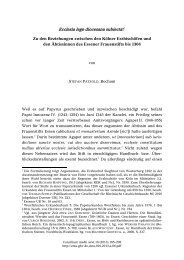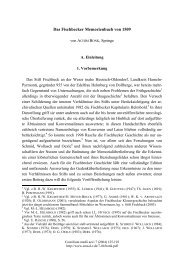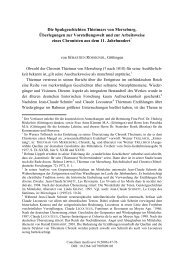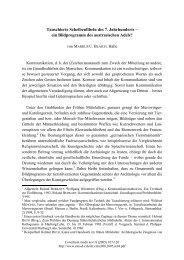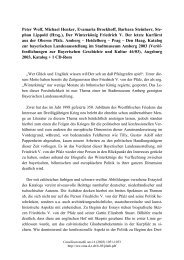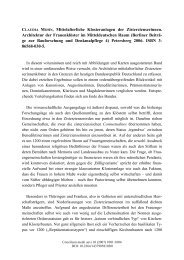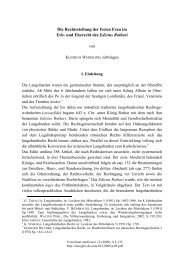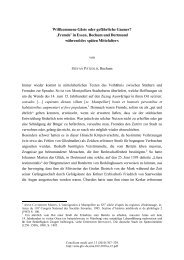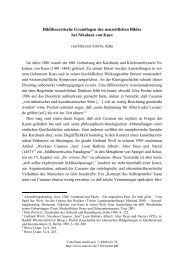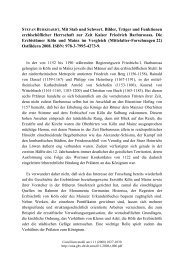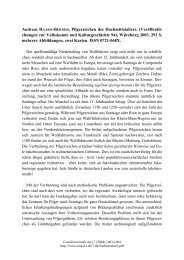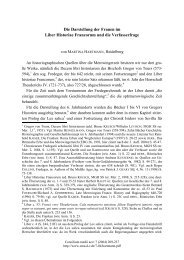Rabanus Maurus - Concilium medii aevi
Rabanus Maurus - Concilium medii aevi
Rabanus Maurus - Concilium medii aevi
You also want an ePaper? Increase the reach of your titles
YUMPU automatically turns print PDFs into web optimized ePapers that Google loves.
4<br />
FEE-ALEXANDRA HAASE: Rhetoric as praise of the emperor<br />
Einhard’s description – so eloquent, that he might have passed for a teacher of<br />
eloquence. We must consider these statements as part of the political ideology of that<br />
time and a praise of the king and following certain traditions of scholarly knowledge<br />
mentioned above. The realisation of this concept by using the ancient education<br />
system based upon the liberal arts. Einhard describes in Life of Charlemagne (25)<br />
Charlemagne as the mentor and cultivator of the artes liberales:<br />
Artes liberales studiosissime coluit, earumque doctores plurimum veneratus magnis<br />
adficiebat honoribus. In discenda grammatica Petrum Pisanum diaconem senem<br />
audivit, in ceteris disciplinis Albinum cognomento Alcoinum, item diaconem, de<br />
Brittania Saxonici generis hominem, virum undecumque doctissimum, praeceptorem<br />
habuit, apud quem et rhetoricae et dialecticae, praecipue tamen astronomiae<br />
ediscendae plurimum et temporis et laboris inpertivit. Discebat artem conputandi et<br />
intentione sagaci siderum cursum curiosissime rimabatur. 4<br />
He most zealously cultivated the liberal arts, held those who taught them in great<br />
esteem, and conferred great honors upon them. He took lessons in grammar of the<br />
deacon Peter of Pisa, at that time an aged man. Another deacon, Albin of Britain,<br />
surnamed Alcuin, a man of Saxon extraction, who was the greatest scholar of the day,<br />
was his teacher in other branches of learning. The King spent much time and labor<br />
with him studying rhetoric, dialectics, and especially astronomy; he learned to reckon,<br />
and used to investigate the motions of the heavenly bodies most curiously, with an<br />
intelligent scrutiny.<br />
According to the image of the philosophically educated king, which goes back to<br />
the Platonic idea of the sovereign as philosopher, Charlemagne joined the school of<br />
Alcuin, attended classes, and fulfilled his scholarly duties. In the school system of<br />
Charlemagne a text was read by a student or teacher accompanied by an explanation.<br />
So the genre dialogue is typical for the teaching system at that time. A master lectured<br />
on various subjects and there was a ‘disputation’. The student would be asked a<br />
multitude of questions and was forced to defend his position with logical arguments.<br />
This method of teaching was responsible for students learning to discipline their<br />
thoughts in Charlemagne’s day, and under the kings who followed, which used the<br />
canon of the artes liberales. 5<br />
4 http://www.noctes-gallicanae.org/Alcuin/Alcuin_epitaphe.htm. [3.9.2003]<br />
5 The text Caroli regis contra synodum from the 790s, traditionally called Libri Carolini, is written in<br />
opposition to the Byzantine empire and its rulers Irene and Constantine. Ommundsen investigated



